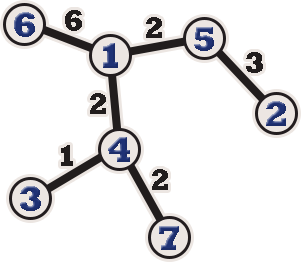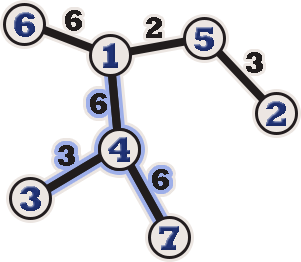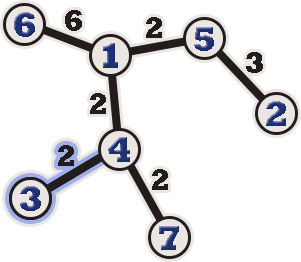310660: CF1866K. Keen Tree Calculation
Description
There is a tree of $N$ vertices and $N-1$ edges. The $i$-th edge connects vertices $U_i$ and $V_i$ and has a length of $W_i$.
Chaneka, the owner of the tree, asks you $Q$ times. For the $j$-th question, the following is the question format:
- $X_j$ $K_j$ – If each edge that contains vertex $X_j$ has its length multiplied by $K_j$, what is the diameter of the tree?
Notes:
- Each of Chaneka's question is independent, which means the changes in edge length do not influence the next questions.
- The diameter of a tree is the maximum possible distance between two different vertices in the tree.
The first line contains a single integer $N$ ($2\leq N\leq10^5$) — the number of vertices in the tree.
The $i$-th of the next $N-1$ lines contains three integers $U_i$, $V_i$, and $W_i$ ($1 \leq U_i,V_i \leq N$; $1\leq W_i\leq10^9$) — an edge that connects vertices $U_i$ and $V_i$ with a length of $W_i$. The edges form a tree.
The $(N+1)$-th line contains a single integer $Q$ ($1\leq Q\leq10^5$) — the number of questions.
The $j$-th of the next $Q$ lines contains two integers $X_j$ and $K_j$ as described ($1 \leq X_j \leq N$; $1 \leq K_j \leq 10^9$).
OutputOutput $Q$ lines with an integer in each line. The integer in the $j$-th line represents the diameter of the tree on the $j$-th question.
ExamplesInput7 5 1 2 1 4 2 3 4 1 2 5 3 6 1 6 4 7 2 2 4 3 3 2Output
18 11Input
3 1 2 1000000000 2 3 1000000000 1 2 1000000000Output
2000000000000000000Note
In the first example, the following is the tree without any changes.

The following is the tree on the $1$-st question.

The maximum distance is between vertices $6$ and $7$, which is $6+6+6=18$, so the diameter is $18$.
The following is the tree on the $2$-nd question.

The maximum distance is between vertices $2$ and $6$, which is $3+2+6=11$, so the diameter is $11$.
Output
给定一棵N个顶点和N-1条边的树,每条边连接两个顶点并具有长度W。主人Chaneka会问Q个问题,每个问题格式如下:如果包含顶点X的每条边的长度都乘以K,那么树的直径是多少?每个问题都是独立的,树的直径是树中任意两个不同顶点之间的最大可能距离。
输入数据格式:
第一行包含一个整数N(2≤N≤10^5)——树的顶点数。
接下来的N-1行,每行包含三个整数U、V和W(1≤U,V≤N;1≤W≤10^9)——连接顶点U和V的边,长度为W。这些边构成一棵树。
第N+1行包含一个整数Q(1≤Q≤10^5)——问题数。
接下来的Q行,每行包含两个整数X和K,如题目所述(1≤X≤N;1≤K≤10^9)。
输出数据格式:
输出Q行,每行一个整数。第j行的整数代表第j个问题的树的直径。
示例:
输入:
7
5 1 2
1 4 2
3 4 1
2 5 3
6 1 6
4 7 2
2
4 3
3 2
输出:
18
11
注意:
在第一个示例中,未修改的树的直径是18,因为顶点6和顶点7之间的最大距离是6+6+6=18。在第二个示例中,修改后的树的直径是11,因为顶点2和顶点6之间的最大距离是3+2+6=11。题目大意: 给定一棵N个顶点和N-1条边的树,每条边连接两个顶点并具有长度W。主人Chaneka会问Q个问题,每个问题格式如下:如果包含顶点X的每条边的长度都乘以K,那么树的直径是多少?每个问题都是独立的,树的直径是树中任意两个不同顶点之间的最大可能距离。 输入数据格式: 第一行包含一个整数N(2≤N≤10^5)——树的顶点数。 接下来的N-1行,每行包含三个整数U、V和W(1≤U,V≤N;1≤W≤10^9)——连接顶点U和V的边,长度为W。这些边构成一棵树。 第N+1行包含一个整数Q(1≤Q≤10^5)——问题数。 接下来的Q行,每行包含两个整数X和K,如题目所述(1≤X≤N;1≤K≤10^9)。 输出数据格式: 输出Q行,每行一个整数。第j行的整数代表第j个问题的树的直径。 示例: 输入: 7 5 1 2 1 4 2 3 4 1 2 5 3 6 1 6 4 7 2 2 4 3 3 2 输出: 18 11 注意: 在第一个示例中,未修改的树的直径是18,因为顶点6和顶点7之间的最大距离是6+6+6=18。在第二个示例中,修改后的树的直径是11,因为顶点2和顶点6之间的最大距离是3+2+6=11。